Old Father Thames: Walking from Source to City... Chapter Eight
Trip Three, Day Two: Reading to Marlow
(Catch up on the previous chapter: Here!)
“The Mole was bewitched, entranced, fascinated. By the side of the river he trotted as one trots, when very small, by the side of a man who holds one spellbound by exciting stories; and when tired at last, he sat on the bank, while the river still chattered on to him, a babbling procession of the best stories in the world, sent from the heart of the earth to be told at last to the insatiable sea.”
― KENNETH GRAHAME, THE WIND IN THE WILLOWS
The hot, bright weather from the preceding day was there to meet us again as we made our way down the steps of the hotel and straight into our eighth morning on the path. The breakfast at the Crowne Plaza had been one of the best on the trip, including that increasingly rare delicacy, black pudding, and served in their stylish and peaceful riverside atrium. We were glad of it as the day was set to be quite a trek, including diversions, of over twenty miles.
Firstly, we needed to leave Reading, as our hotel at Caversham bridge was at the western edge of the centre. The relationship of a large town to its river is more often than not one of symbiosis. The river provides an important trade and transport artery to the town and in return it is given pride of place at the heart of civic life, lined with proud embankments and grand hotels and bridged with baroque splendour. Reading, however, entirely turns its back on the Thames, which quietly slips through the town at the end of residential back-streets, along a narrow willow-lined corridor of green. As such, one would hardly know that we were in the heart of an industrial town and the first few miles of our walk were surprisingly tranquil and bucolic. With a tarmac towpath underfoot, we made good progress, passing the back of offices and the occasional boat house on the many long thin islands in the middle of the river. Before long we crossed the confluence of the Kennet and the Thames, passed Reading University’s Rowing Club and, with a gosling guard of honour, departed Reading.
Our first planned stop that day was Sonning, a small village, now hovering on the edge of an ever-expanding Reading, which is famed for its prettiness and riverside charm - or as Jerome K Jerome put it, "the most fairy-like little nook on the whole river.” After a few miles on a tree-shadowed path, gently meandering this way and that in great smooth curves, we arrived at Sonning Lock and were faced with a quandary. The information board quoted a small extract from a poem by James Sadler (1845-85): ‘bee-keeper, poet, and Sonning Lock Keeper’:
Is there a spot more lovely than the rest,
By art improved, by nature truly blest?
A noble river at its base running,
It is a little village known as Sonning.
Dad and I had always pronounced the name of this village as Sohnning, but the rhyme in this poem (from the Lock Keeper himself no less) suggests it's closer to Sunning. We decided a second opinion was required before we amended our habit of a lifetime, the amateur poetry of a nineteenth-century beekeeper not being the most trustworthy source, so we carried on into the village to find a local.
We did so at The Bull, possibly the most attractive village pub I have ever laid eyes upon. Forming two sides of a courtyard, with the wall of the churchyard making the third, this two-story, half-timbered, coaching inn was festooned in deep-green climbers which basked in the mid-morning sun. Originally built by the Bishops of Salisbury, whose palace was nearby, as a hostel for pilgrims, it is still today owned by the church of St Andrew next door, who only lease it to Fuller’s brewery. It is emphatically recommended by Jerome who writes:
“If you stop at Sonning, put up at the "Bull," behind the church. It is a veritable picture of an old country inn, with green, square courtyard in front, where, on seats beneath the trees, the old men group of an evening to drink their ale and gossip over village politics; with low, quaint rooms and latticed windows, and awkward stairs and winding passages.”
All it was missing that morning were the ‘old men’, so we took our places under the wisteria and enjoyed half a pint while the friendly barman explained that, as far as he was concerned, it was Sohnning and not Sunning, so suitably reassured we departed. (I have subsequently found that the confusion stems from a ‘typo’ in the Domesday Book, the Saxon name of Sunningas was translated as Soninges by the Normans - causing centuries of confusion.)
Before we left charming Sonning, I wanted to try and catch a glimpse of my favourite house in all England. The Deanery, just behind the pub, was built by Edwin Lutyens for his friend, the founding editor of Country Life, Edward Hudson, with gardens laid out by Gertrude Jekyll. It is typical of Lutyens’ hybrid of historic British vernaculars with modern comfort and art deco flourishes, Arts & Crafts meets international modernism in a peaceful rural village. Unfortunately the house and garden are not open to the public and the high walls all around the property give nothing away other than the elaborate chimneys. It is apparently now the country home of Led Zeppelin guitarist Jimmy Page, whose London pad is the fairytale gothic-revival architect William Burges’ Red Tower in Holland Park. An international rock star of impeccable architectural taste!

This disappointment aside, we cross the old red-brick bridge and continue, out into the fields and meadows, towards Shiplake and Wargrave. This is a surprisingly lonely stretch of the river, given how we are entering the heartland of the posh Thames Valley set. Neither Shiplake nor Wargrave make themselves known to the river with any great panache, the odd house or villa might wander down to the water’s edge but we pass neither pub nor shop nor church for quite some miles. Instead, we skirt the edges of fields, high with dry grasses, and barges hidden behind the reeds, the boat-dwellers' paths of flattened stalks the only sign of their existence.
As we approach Lower Shiplake, and beyond it Bolney Court, the path forces us away from the river and quite significantly inland. To avoid the ire of an eighteenth-century landowner, the historic towpath crossed to the other bank by ferry here and returned the same way a few miles downstream, but both ferries are gone now so we must make the detour. However, Lower Shiplake is interesting enough, if a little ‘stockbroker Tudor’ in style, but the gardens are kept immaculately. George Orwell grew up in Lower Shiplake, and Alfred Lord Tennyson was married in a church a few miles up the road. The Henley Branch Line cuts through the middle of the village and the tiny railway halt is marked ‘Shiplake for The Thames Path’.
As we continue towards Henley the houses and gardens grow in size and grandeur until eventually we are passing only large gates with the houses invisible in the distance, presumably down on the riverbank. The most interesting of hidden homes is Thames Side Court, where, through the railings, a large and complex miniature railway is visible weaving between the hedges and trees before reaching a climax on the lawn in a seven-foot tall scale model of the station at St Moritz. This was previously the home of Urs Schwarzenbach, a Swiss financier who, a few years ago, was heavily fined by Swiss authorities for smuggling 83 works of art into the country without customs clearance, and in 2022 was ordered to pay over £140M in missed taxes. Surprisingly, this is not the last we will hear of Herr Schwarzenbach on today's walk…
Henley is the most attractive of all Thameside towns. The river here is just wide enough to be grand without the opposite bank being out of reach, pleasure boats of all sizes and ages line the quaysides which run up to a perfectly proportioned Georgian bridge with its accompanying pub and tall square church tower. St Mary the Virgin is the tallest structure in the town and thus still gives Henley its distinctive skyline. Beyond the bustling riverfront, the road from the bridge runs inland, lined with expensive interior design shops and celebrity chef restaurants, until it meets the Edwardian baroque town hall, in front of which is the main crossroads, a layout that hasn't much changed since the Thirteenth Century. We make our way up this street in search of some sandwiches, which we then take to eat on a bench in the quiet churchyard. It's now very hot and we’re grateful for the shade of a yew tree as we watch the light rake across the varied facades of the almshouses, some very ancient, others quite modern, that surround the graves. An old man in a straw hat and smart blazer with tie walks slowly past and greets us. He has the bearing of a long retired Wing Commander or Brigadier, and, in Henley, could well be such.
A memorial for the singer Dusty Springfield is strewn with dry and decaying flowers near the west door, which we enter and pass into the comforting cool gloom of an old church. St Mary’s is really a combination of several churches of different periods, the site dates back to before the Norman conquest but nothing physical remains of any structure before the Thirteenth Century - of which there are fragments. Most of what is visible on the outside comes from a rebuilding in the Fifteenth Century, and the interior was modified beyond all recognition by the Victorians. The high roof of the nave accommodates a large fresco on the chancel arch by the priest-architect Rev’d Ernest Geldart, which, the information leaflet advises, is based upon Jan van Eyck’s Ghent Altarpiece… although to my eye there is much more of Rossetti and Morris about it than that master of the Flemish renaissance.
In a side chapel is the elaborate tomb of Elizabeth Bacon (d.1621), the half-sister of Sir Francis Bacon and the dedicatee of music composed by both William Byrd and Thomas Morley. She married three times amongst the gentlemen of the Tudor privy council, with her own personal fortune growing with the death of each spouse, until she became established as the Lady of Greenlands, a large manor on the edge of Henley. In her lifesize tomb effigy, she is propped up on her elbow, having just looked up from the book she holds to the ground as she heard your footsteps approach, just as sharp and alert in death as her biography suggests she was in life.
We stop for a quick half at The Angel pub, right next to the bridge, and sit in the sun on their benches on the quay. This is one of the legendary Thames pubs, a landmark on the journey. As we set off again, across the bridge and onto the path beyond, I began to regret the added weight to my backpack from the impulse purchase of several heavy books in the Henley Oxfam - but a cheap Pevsner guide simply can’t be left on the shelf!
Around us, they are in the throes of setting up for the regatta, grandstand and boxes, signage, car parks, temporary bars, timing booths and docking points are all being hastily constructed along the very straight and wide stretch of water from Henley bridge to Temple Island. It is a hive of activity, workmen in high-vis being directed by old men in linen blazers and the distinctive pale-pink trousers of the Leander Club, the world-famous rowing club with a pink hippo on its badge. We are grateful for the occasional splash of cool water from sprinklers, keeping the grass green and fresh around the grandstands whilst it is yellow and dying everywhere else. It is a scene so quintessentially English that you’d almost believe it was written by a Hollywood script-writer; a languorous summer’s afternoon, old couples in formal attire promenade along a path lined with perfectly kept rose gardens on one side and cheerful boaters on the other, every now and then we pass groups of young sunkissed people in rowing kit, down from the best schools and colleges in the country to prepare for the following week’s races. To top it all off, this peace is briefly disturbed by the distinctive sound of two Spitfires, passing low over the miniature classical temple on an island in the river, departing a nearby airshow.
We leave this scene from interbellum England and the river along with it, cutting inland to The Flower Pot Hotel. This charmingly named establishment, right on the path, is recommended in all the guides. And whilst perfectly pleasant, its pristine and stylish interior lacks something of the soul that our predecessors had raved about. The bar is empty and the first barman we encounter is offish and brisk, he seems annoyed that we have come into his pub and disturbed the lazy afternoon quiet. Subsequently, we get talking to a second barman who could not be more friendly, and we begin to warm to the pub thanks to his cheerful chat. We discuss the various aspects of the path and he tells us of attractive stretches ahead. He also reveals that The Flower Pot has recently been sold and refurbished, the old interior and soul done away with and the prices increased, indeed the only thing left of the original pub seems to be the barman himself, and he speaks somewhat wistfully of the old Flower Pot with a smile. Here is a metaphor for what's happening to pubs across the country: the soul is being sold to the highest bidder, ripped out and replaced with a gastro-moneymaker. The old staff who knew all the regulars, were welcoming to strangers, could chat over the pumps and knew their local patch like a telephone directory, are being phased out by zero-hours wage slaves, beholden only to the brewery conglomerate who over-work them to the point of exhaustion.
After the Flower Pot, we cut through the Culham Court Estate. This begins as a large wildflower meadow, before we pass in front of a red-brick Queen-Anne-style country home, with a view across the river below, and the vale beyond, all the way to the Chilterns. Of course, carefully placed hedges cut off any chance of a snoop into the property. Built by William Chambers in the early Eighteenth Century, it was later owned by Sir Henry Barber, the great developer of Birmingham’s Victorian suburbs and namesake of the Barber Institute of Fine Art in the city today. Later still it became home to the Berhens family and played host to artists such as Hugh Casson and Edward Ardizzone, until most recently, it was purchased by, ‘friend of the Swiss tax office’, Herr Schwarzenbach. It was he who developed the extensive deer park which we continue on through to rejoin the riverside. A rolling landscape interspersed with carefully arranged trees and, keeping their distance, bright white deer.
Once we’re beyond this slightly surreal setting, we continue through fields of sheep, passing only the occasional bunch of riverside homes, for what seems like an age. It is always the final five or six miles of a day that last the longest. On the opposite bank we spot Medmenham Abbey, of twelfth-century Cistercian origins, it gained notoriety in the Eighteenth Century for playing host to the debauchery and bacchanalian revels of Sir Francis Dashwood’s Hellfire Club. Sadly, it looks eminently respectable today.
We reach Hurley Lock, unfortunately too late for the Lock Keeper’s cafe, and must take a diversion from the path once again. Temple Lock footbridge has been closed for urgent repairs so the final few miles to Marlow must be made on through the back lanes. Despite adding very little distance to our journey, we find this diversion exhausting and tedious. Finally, we arrived at the gates of Bisham Abbey National Sports Centre. The history of the Abbey and subsequent manor will be told in the following chapter, but the sports complex that now occupies much of the site, which has been home to England’s national rugby and football teams, was to be our stopping point for the night. The on-site hotel was much like any standard chain hotel but was perfectly suitable for us after a long hot walk. I checked the tracker once we got to our room, 21 miles, our longest day yet on the journey.
Later that evening we walked the final mile or so into Marlow for dinner.
Next time: …a sudden change of plan, Stanley Spencer’s Cookham, the Bargees’ Church, and a King’s Castle…
(Thank you for reading! If you enjoyed, please consider subscribing to get all future instalments sent straight to your email inbox. You can also choose to support my writing (and walking) by choosing a paid subscription option.)





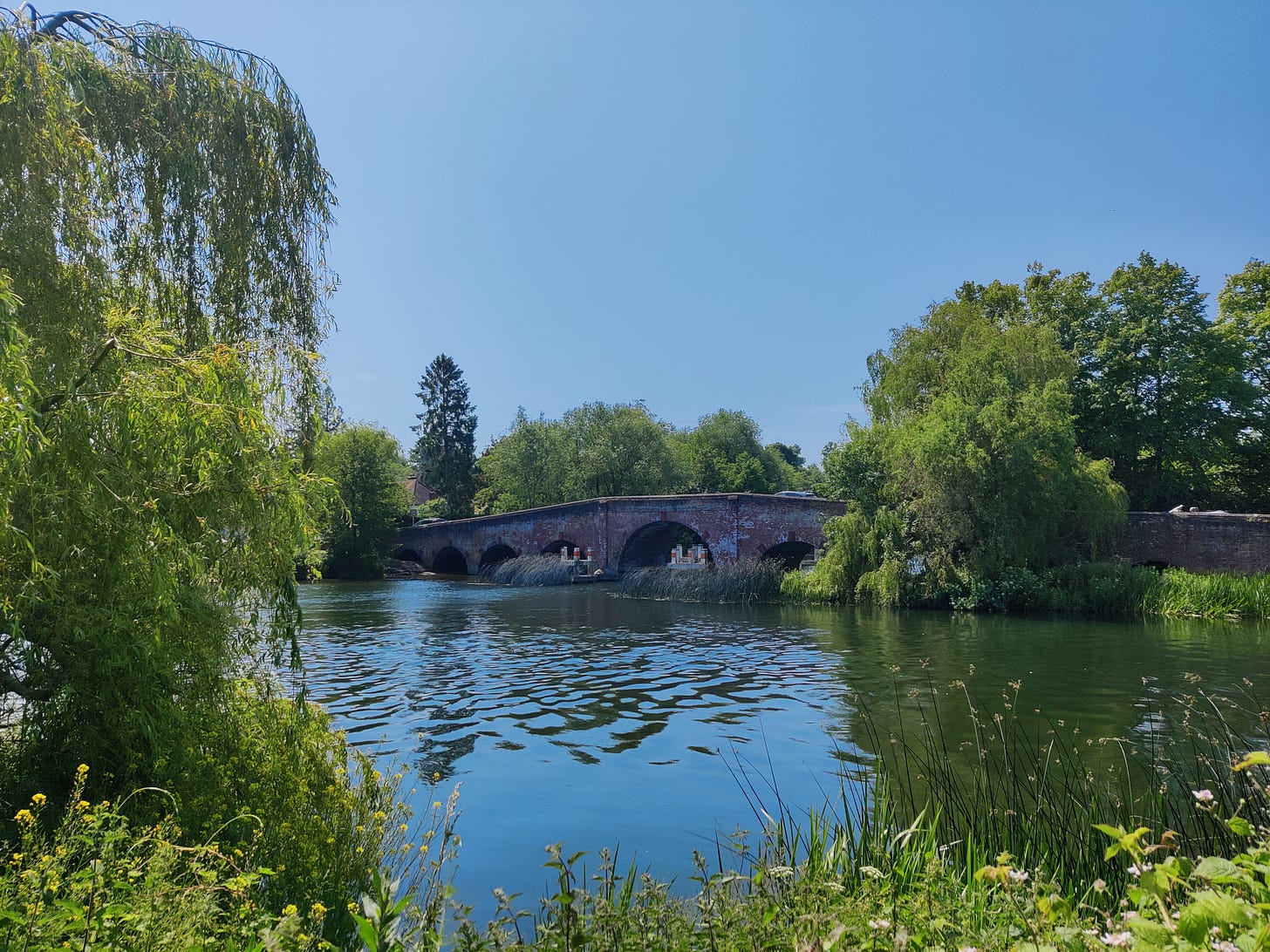
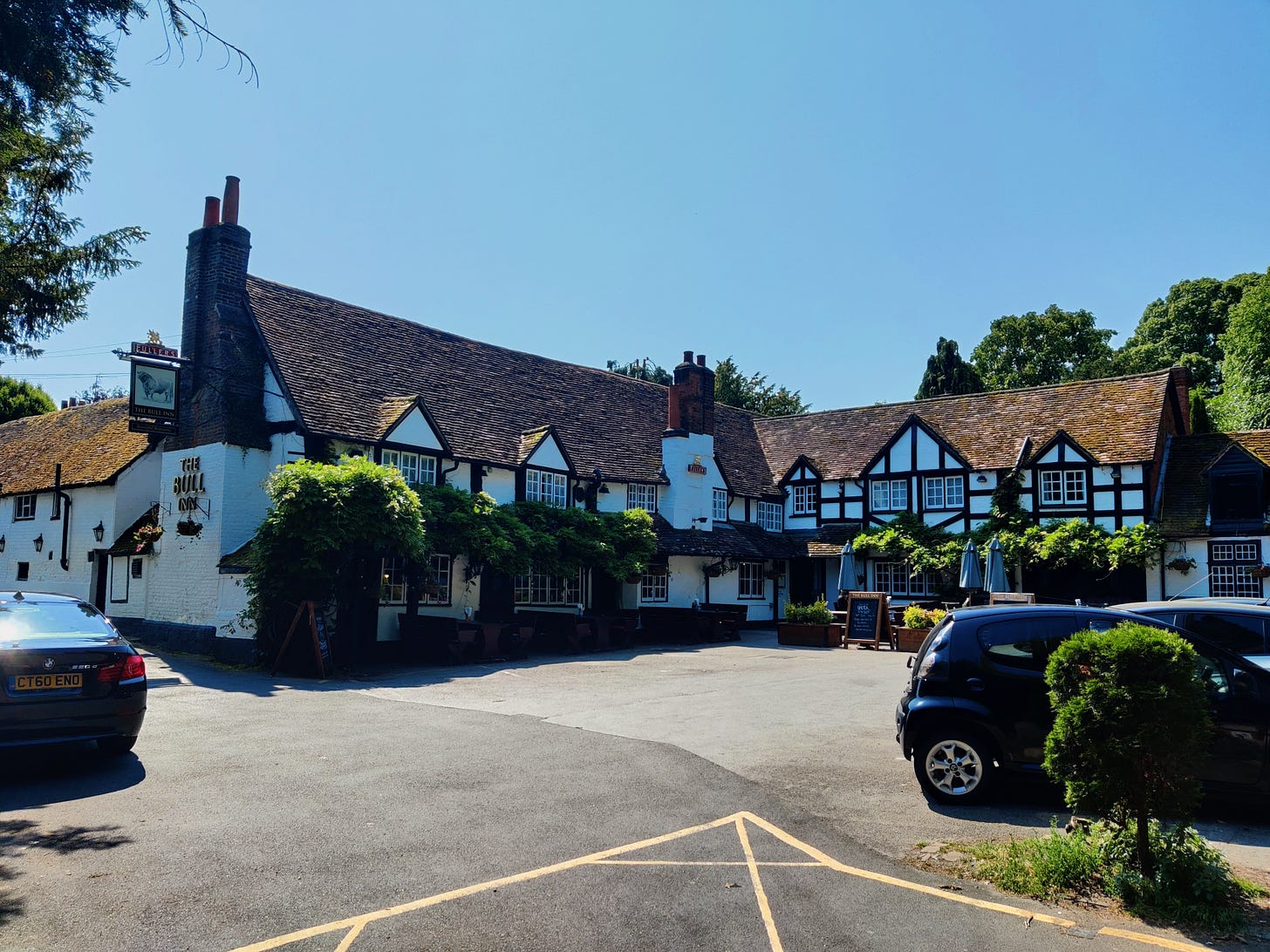
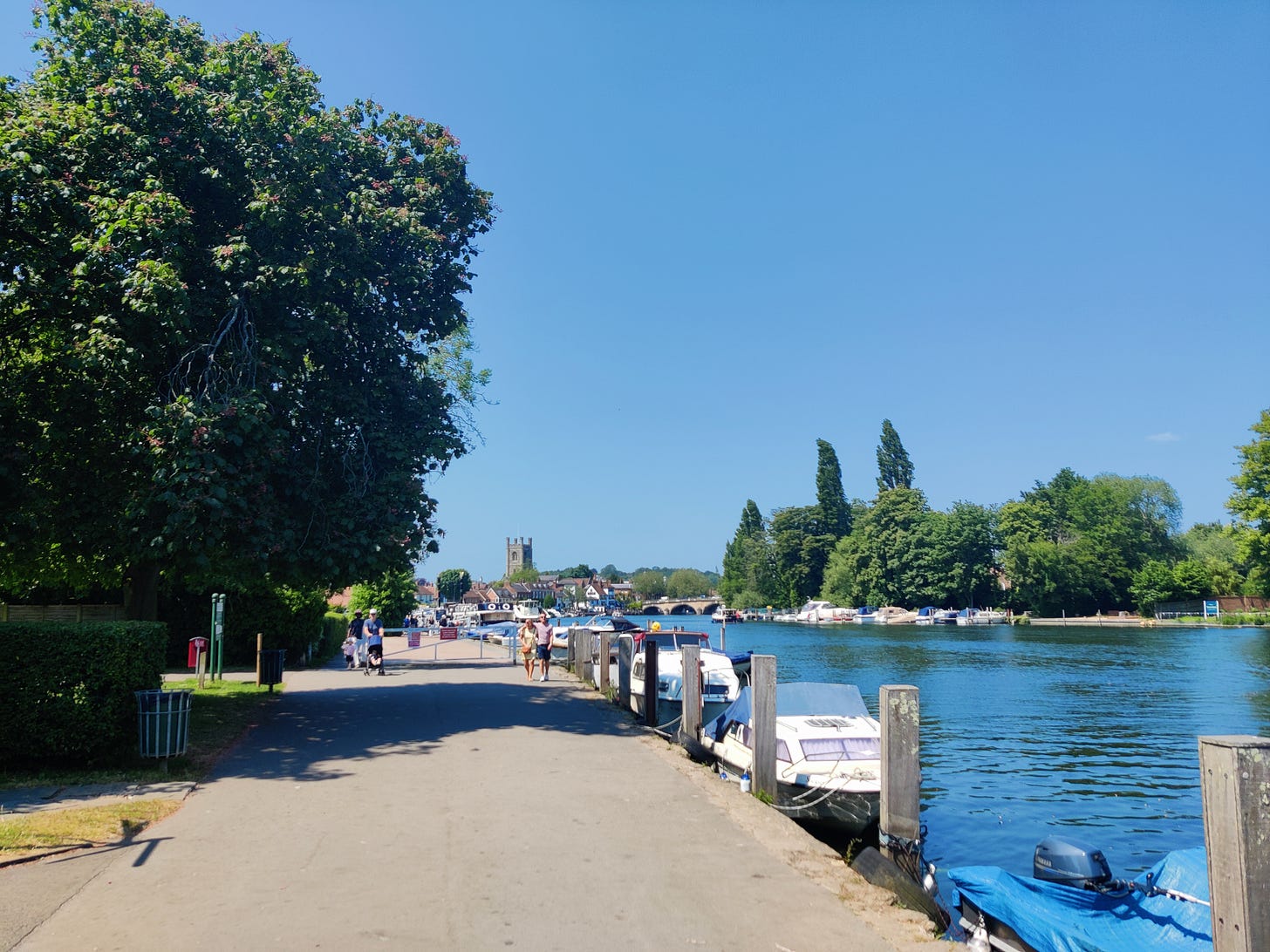
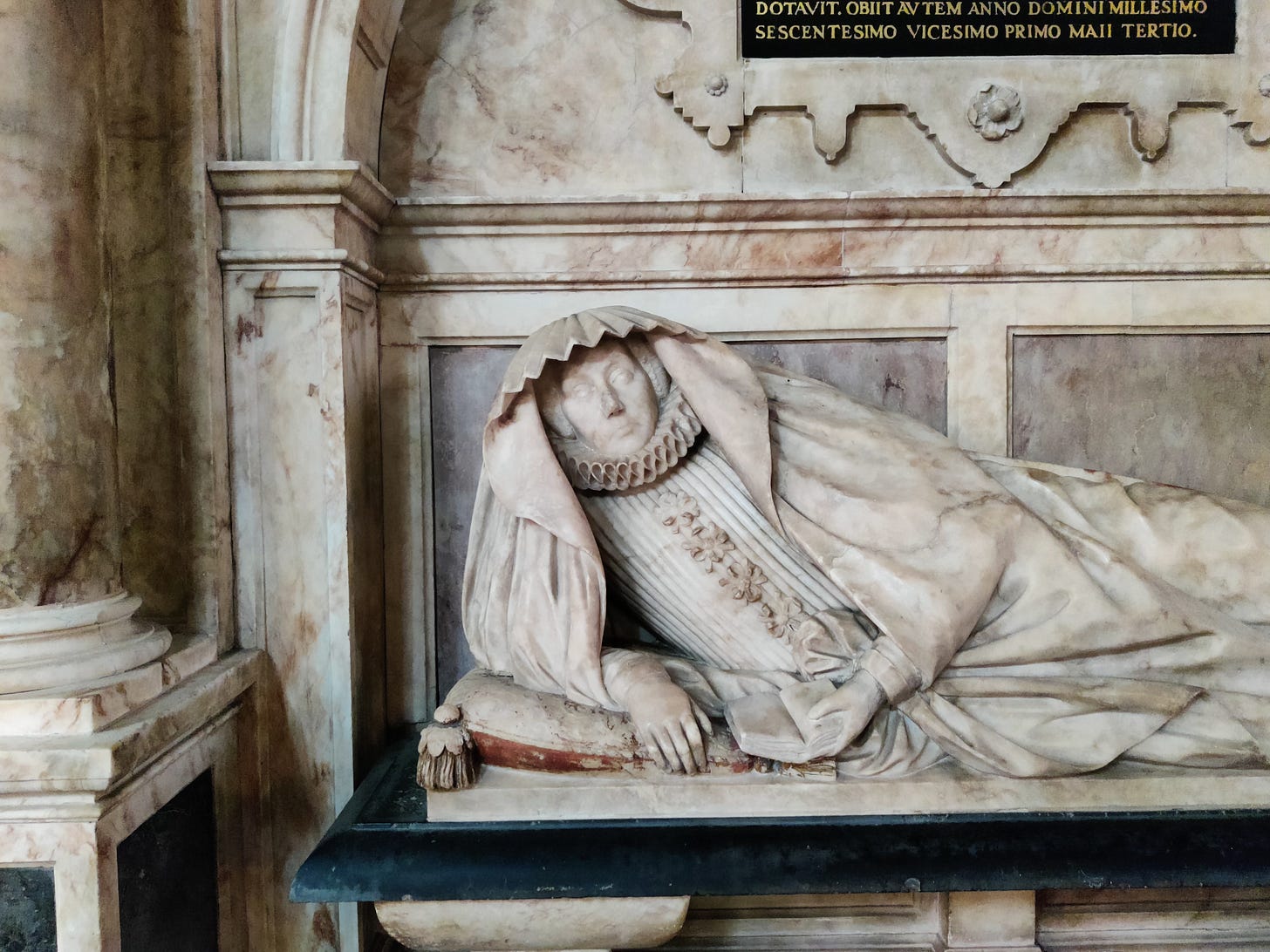
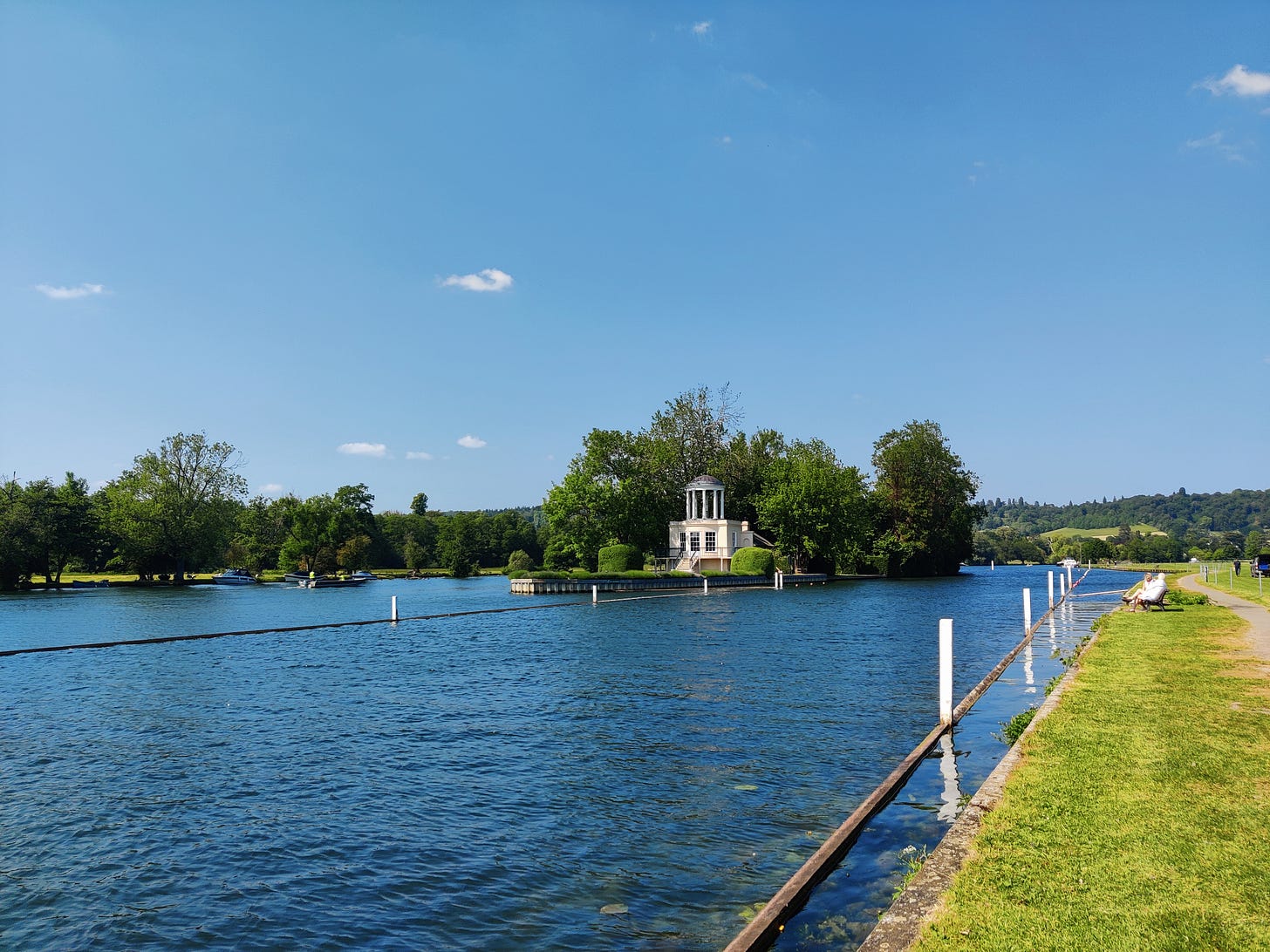
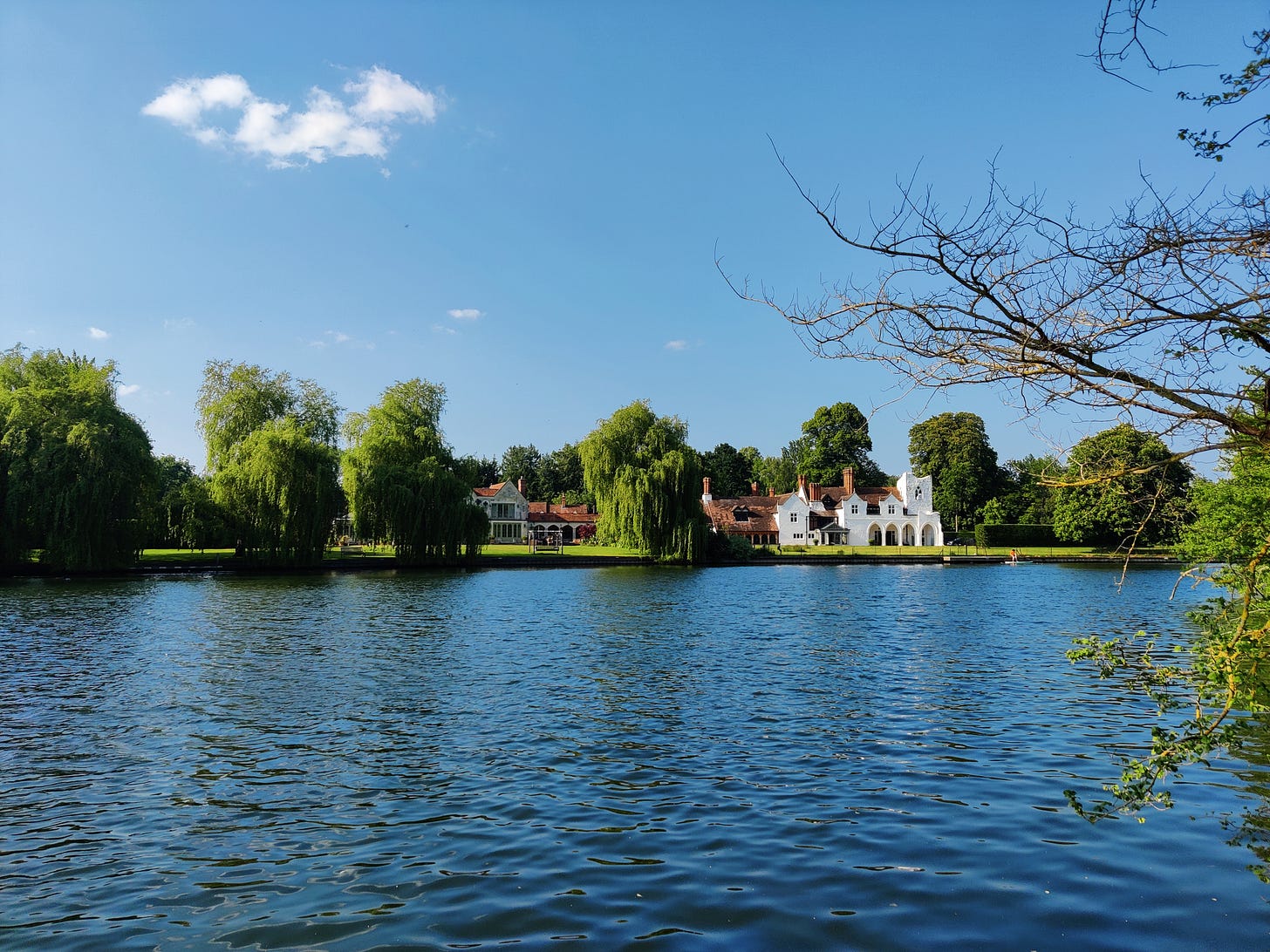
What a lovely start to my day having a stroll along the Thames with you both. As ever, such descriptions of the places and people you encounter create a vivid picture. Looking forward to the next instalment.